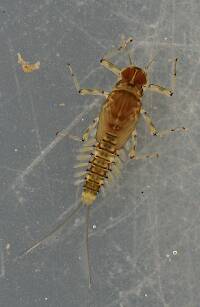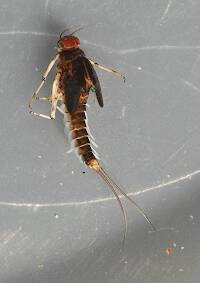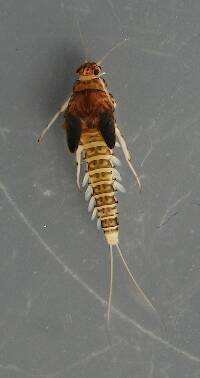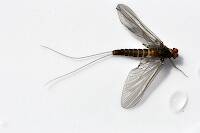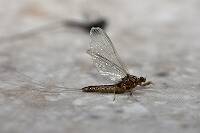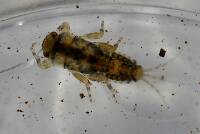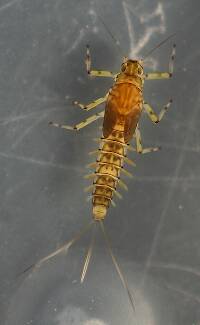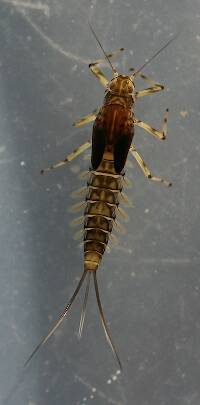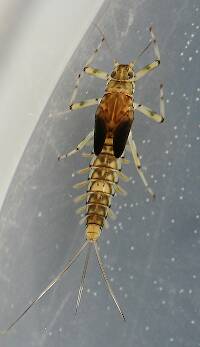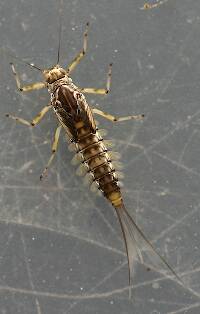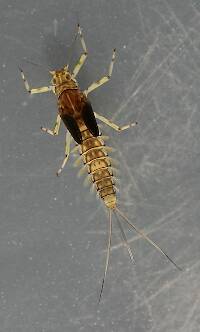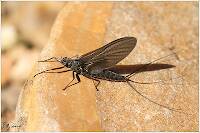
Blue-winged Olives
Baetis
Tiny Baetis mayflies are perhaps the most commonly encountered and imitated by anglers on all American trout streams due to their great abundance, widespread distribution, and trout-friendly emergence habits.
Featured on the forum

This is the first of it's family I've seen, collected from a tiny, fishless stream in the Cascades. The three species of this genus all live in the Northwest and are predators that primarily eat stonefly nymphs Merritt R.W., Cummins, K.W., and Berg, M.B. (2019).

Troutnut is a project started in 2003 by salmonid ecologist Jason "Troutnut" Neuswanger to help anglers and
fly tyers unabashedly embrace the entomological side of the sport. Learn more about Troutnut or
support the project for an enhanced experience here.
Feathers5
Posts: 287
Posts: 287
Feathers5 on Feb 9, 2012February 9th, 2012, 5:34 am EST
I was speaking with my buddy, gutcutter, last night and we were discussing paraleptophlebias. If I remember correctly, he felt the Adoptiva's were sizes 16 and 18, and the later mollis's about a 20. In Al Caucci's book, Hatches, he has them both listed as 18 & 20s. Anyone care to wade in on this discussion? Antonio knows of what he speaks, well, most of the time, so I defer to him.
Oldredbarn on Feb 9, 2012February 9th, 2012, 7:20 am EST
Antonio knows of what he speaks, well, most of the time, so I defer to him.
Ha! Ha! Good call there Bruce...You get to keep your reservation to the top-bunk in the camper...:)
IMHO...as apposed to Tony's NSHO...:) A 16 will catch you fish during an adoptiva emergence, but an 18 is more accurate...I don't have my cheat sheets here at the office or I might give you the actual millimeters from my notes...
If Tony is on the same page as my logic... Then, if the fish get hard to deal with toss them the 18...If they aren't so nit-picky tie on the 16 and try to cast as well as he does...From what I hear anyway. :)
Spence
I forgot P mollis...I know that Leonard has mentioned this fly and we probably get it here, I can't say I've seen it, but P debilis is our later season cousin and its pretty close to adoptiva in size...It could very well be that P mollis, if it shows here in any numbers may get mixed in, in the mind of the casual angler, with the Baetids that seem to always be present here in one form or another.
"Even when my best efforts fail it's a satisfying challenge, and that, after all, is the essence of fly fishing." -Chauncy Lively
"Envy not the man who lives beside the river, but the man the river flows through." Joseph T Heywood
"Envy not the man who lives beside the river, but the man the river flows through." Joseph T Heywood
PaulRoberts on Feb 9, 2012February 9th, 2012, 9:37 am EST
Bruce,
I’ve looked at my records for you, so I’m not just flying by the seat of my pants trying to remember things. And then I checked what some of the experts (besides Tony) have said.
From my own self-produced hatch chart from the Ithaca NY area:
Paraleptophlebia -mollis June 1-June 20 Size 16,18 Pale dun/brown, with olive cast (fresh). Moderate runs, riffle edges; Depositional substrate.
Paler (grayer) than the earlier adoptiva, and about a hook size smaller. When first emerged they look dun gray and brown, with an olive cast (highlights), then darken. Fresh duns look a lot like Baetis on the wing (all wing).
I tied #18 (Mustad) Comparaduns and Parachutes and felt that these ties were virtually interchangeable for Baetis and P molls in effect. But, I found a #18 too small to be effective as an indicator (and sometimes just tougher to see) so I use a #16 too. These larger dries caught fish too though, but an 18 was better –just as is true during tricaudatus emergences.
As to habitat, you may notice I mention "depositional substrate" above. I believe that Baetis and Paralep habitat separates in the current speeds they experience / are built to handle. You might have noticed (or can ask Tony) that Baetis nymphs can be found on top of and along the sides of rocks in riffles –often exposed to current. Paraleps, although apt to be found in the same riffles, are deeper under the rocks, down where softer sediments are able to be deposited. I’d have to check but I’d bet the two feed differently, have differing mouth parts and associated paraphernalia. Interesting that one Paralep (bicornuta) has tusks like the burrowers have. I’m making an educated guess here that Paraleps cannot handle the currents that Baetis can, and require depositional substrates to feed in. Although both Baetis and Paraleptophlebia live in the same riffles, I am under the impression that Baetis can emerge within faster currents (right from riffle rock tops) whereas Paraleps must use slower pockets of current to emerge, even migrating to riffle edges in some riffles.
As to habits, notice that while Baetis nymphs might flip around in your hand like little fish, Paralep nymphs crawl feebly, wriggling like a worm at best.
What some “experts” say:
Al Caucci (Delaware):
Size 16, 18
June 6 to 15
“Paralep nymphs prefer slow to moderate water, and their streamlined appearance is very similar to those of the Baetis nymph.”
Delaware guide Jerry Hadden:
Size: 18, 20
“Paraleptophlebia mollis nymphs habitat consists of medium flowing currents. Duns are more grayish in color, and have wider lighter stripes on it's abdomen than adoptiva. The male spinners abdomen is almost clear, while the female is dark brown. Male and female both have cream or white colored legs.”
Charlie Meck (PA):
Size 18 “Blue Quill”, morning to afternoon, late May start, found in “all water types”.
Lloyd Gonzalez:
… All of the Eastern Blue Quill duns look about the same and are similar in size (about #16-18) … Look for the duns to emerge in side pockets, stream edges, and eddies from late morning into early afternoon.
Pertaining to potential size variation:
CORKUML,. D. 1978. The nymphal development of Paraleptophlebia adoptiva (McDunnough) and Paraleptophlebia mollis (Eaton) (Ephemeroptera: Leptophlebiidae) and the possible influence of temperature.
Can. J. Zool. 56: 1842-1846.
Nymphal development of Paraleptophlebia adoptiva (McDunnough) and Paraleprophlebia mollis (Eaton) was studied in the West and East branches of the Credit River, Peel County, Ontario. Nymphs of P. adoptiva were found only in the cooler water of the West branch; they continued to grow during winter months and had a short emergence period in mid-May. Paraleprophlebia mollis nymphs occurred in both branches, nymphs in the West branch being significantly smaller than those of the East. No growth was observed for P. mollis nymphs in winter and a protracted emergence period for this species throughout June was evident. Both mayfly species are univoltine.
Hopefully, Bruce, I have helped satisfy your curiosity some. If not, get your waders on and get busy. You have until mid June to view this year’s crop. We’d all love to hear what you see.
I’ve looked at my records for you, so I’m not just flying by the seat of my pants trying to remember things. And then I checked what some of the experts (besides Tony) have said.
From my own self-produced hatch chart from the Ithaca NY area:
Paraleptophlebia -mollis June 1-June 20 Size 16,18 Pale dun/brown, with olive cast (fresh). Moderate runs, riffle edges; Depositional substrate.
Paler (grayer) than the earlier adoptiva, and about a hook size smaller. When first emerged they look dun gray and brown, with an olive cast (highlights), then darken. Fresh duns look a lot like Baetis on the wing (all wing).
I tied #18 (Mustad) Comparaduns and Parachutes and felt that these ties were virtually interchangeable for Baetis and P molls in effect. But, I found a #18 too small to be effective as an indicator (and sometimes just tougher to see) so I use a #16 too. These larger dries caught fish too though, but an 18 was better –just as is true during tricaudatus emergences.
As to habitat, you may notice I mention "depositional substrate" above. I believe that Baetis and Paralep habitat separates in the current speeds they experience / are built to handle. You might have noticed (or can ask Tony) that Baetis nymphs can be found on top of and along the sides of rocks in riffles –often exposed to current. Paraleps, although apt to be found in the same riffles, are deeper under the rocks, down where softer sediments are able to be deposited. I’d have to check but I’d bet the two feed differently, have differing mouth parts and associated paraphernalia. Interesting that one Paralep (bicornuta) has tusks like the burrowers have. I’m making an educated guess here that Paraleps cannot handle the currents that Baetis can, and require depositional substrates to feed in. Although both Baetis and Paraleptophlebia live in the same riffles, I am under the impression that Baetis can emerge within faster currents (right from riffle rock tops) whereas Paraleps must use slower pockets of current to emerge, even migrating to riffle edges in some riffles.
As to habits, notice that while Baetis nymphs might flip around in your hand like little fish, Paralep nymphs crawl feebly, wriggling like a worm at best.
What some “experts” say:
Al Caucci (Delaware):
Size 16, 18
June 6 to 15
“Paralep nymphs prefer slow to moderate water, and their streamlined appearance is very similar to those of the Baetis nymph.”
Delaware guide Jerry Hadden:
Size: 18, 20
“Paraleptophlebia mollis nymphs habitat consists of medium flowing currents. Duns are more grayish in color, and have wider lighter stripes on it's abdomen than adoptiva. The male spinners abdomen is almost clear, while the female is dark brown. Male and female both have cream or white colored legs.”
Charlie Meck (PA):
Size 18 “Blue Quill”, morning to afternoon, late May start, found in “all water types”.
Lloyd Gonzalez:
… All of the Eastern Blue Quill duns look about the same and are similar in size (about #16-18) … Look for the duns to emerge in side pockets, stream edges, and eddies from late morning into early afternoon.
Pertaining to potential size variation:
CORKUML,. D. 1978. The nymphal development of Paraleptophlebia adoptiva (McDunnough) and Paraleptophlebia mollis (Eaton) (Ephemeroptera: Leptophlebiidae) and the possible influence of temperature.
Can. J. Zool. 56: 1842-1846.
Nymphal development of Paraleptophlebia adoptiva (McDunnough) and Paraleprophlebia mollis (Eaton) was studied in the West and East branches of the Credit River, Peel County, Ontario. Nymphs of P. adoptiva were found only in the cooler water of the West branch; they continued to grow during winter months and had a short emergence period in mid-May. Paraleprophlebia mollis nymphs occurred in both branches, nymphs in the West branch being significantly smaller than those of the East. No growth was observed for P. mollis nymphs in winter and a protracted emergence period for this species throughout June was evident. Both mayfly species are univoltine.
Hopefully, Bruce, I have helped satisfy your curiosity some. If not, get your waders on and get busy. You have until mid June to view this year’s crop. We’d all love to hear what you see.
Gutcutter on Feb 9, 2012February 9th, 2012, 4:03 pm EST
I was speaking with my buddy, gutcutter... he felt the Adoptiva's were sizes 16 and 18, and the later mollis's about a 20.
To set the record straight, I was driving home from work around 9:30 last night, while we were discussing the hatches that we will be fishing in late April. I said that the P. adoptiva/Blue Quill/Mahogany Dun is a solid size 18, but a 16 can sometimes be effective, too. There are enough Red Quills around, and the hatches often overlap.
In the summer, the P. adoptiva/Blue Quill/Jenny Spinners are closer to a 20.
...And then I checked what some of the experts (besides Tony) have said....
You might have noticed (or can ask Tony) that Baetis nymphs can be found on top of and along the sides of rocks in riffles –often exposed to current. Paraleps, although apt to be found in the same riffles, are deeper under the rocks, down where softer sediments are able to be deposited. I am under the impression that Baetis can emerge within faster currents (right from riffle rock tops) whereas Paraleps must use slower pockets of current to emerge, even migrating to riffle edges in some riffles...
I have never claimed to be an expert, but I have noticed that the Baetis emerge mid stream in the faster water, while the Paraleps emerge in the slower water along the banks. I have seen this only with the summer hatches, as the P. adoptiva rarely hatch at the same time as the Baetis, but the P. mollis and the Baetis do.
Also, in short riffles, the baetis seem to get in the air at the head of the downstream pool, while the paraleps will often ride well down into the middle of it before getting airborne.
I have also observed that the spring time P. adoptiva spinners and their simultaneously falling cousins (E. subvaria) will concentrate over the same riffles, producing interesting fishing in the pools below. There will be slightly different colored spinners in 14, 16 and 18 on the water at the same time. It can be similar to figuring out if the fish are taking trico males or females.
Unfortunately, I have yet to find a fishable spinner fall of P. mollis. Many, many spinners in the air, yet I never see them on the water.
Any guesses out there as to why this happens?
Do they drop late in the evening, or do they crawl in/dive in like the Baetis do?
All men who fish may in turn be divided into two parts: those who fish for trout and those who don't. Trout fishermen are a race apart: they are a dedicated crew- indolent, improvident, and quietly mad.
-Robert Traver, Trout Madness
-Robert Traver, Trout Madness
Entoman on Feb 9, 2012February 9th, 2012, 5:03 pm EST
Hi Tony,
Check out the Paraleptophlebia hatch page. I revised it the other day to help fill out the picture more on this genus. If you scroll down to the "Spinner Behavior" section, I think you'll find it answers your questions as well as confirming your observations.
http://www.troutnut.com/hatch/47/Mayfly-Paraleptophlebia-Blue-Quills-&-Mahogany-Duns
Many, many spinners in the air, yet I never see them on the water.
Any guesses out there as to why this happens?
Do they drop late in the evening, or do they crawl in/dive in like the Baetis do?
Check out the Paraleptophlebia hatch page. I revised it the other day to help fill out the picture more on this genus. If you scroll down to the "Spinner Behavior" section, I think you'll find it answers your questions as well as confirming your observations.
http://www.troutnut.com/hatch/47/Mayfly-Paraleptophlebia-Blue-Quills-&-Mahogany-Duns
"It's not that I find fishing so important, it's just that I find all other endeavors of Man equally unimportant... And not nearly as much fun!" Robert Traver, Anatomy of a Fisherman
PaulRoberts on Feb 10, 2012February 10th, 2012, 2:57 am EST
Thanks for chiming in Tony.
I can't add anything about the spinners. I don't believe I've seen a mollis fall.
I can't add anything about the spinners. I don't believe I've seen a mollis fall.
Oldredbarn on Feb 10, 2012February 10th, 2012, 4:36 am EST
I have also observed that the spring time P. adoptiva spinners and their simultaneously falling cousins (E. subvaria) will concentrate over the same riffles, producing interesting fishing in the pools below. There will be slightly different colored spinners in 14, 16 and 18 on the water at the same time.
Tony,
This is just an aside and don't hold me to it, but I've had the same situation you discribe here and then again in late May with different bugs during the evening spinner fall. I would start to catch fish just by changing the size of my spinner imitation and I would bet that my best fishing usually began when I went down a size or so...You would think bigger fly more protein...Must be more flies equals more protein or the fish are more used to seeing the smaller sized bugs.
Maybe there is a "mean" size to all the bugs a fish sees over a season and he's more comfortable feeding in that size range...? That's a wild thought! Better head off in to the kitchen for my second cup of tea...:)
Maybe this explains the success of a size 16 anything...?
Spence
"Even when my best efforts fail it's a satisfying challenge, and that, after all, is the essence of fly fishing." -Chauncy Lively
"Envy not the man who lives beside the river, but the man the river flows through." Joseph T Heywood
"Envy not the man who lives beside the river, but the man the river flows through." Joseph T Heywood
PaulRoberts on Feb 10, 2012February 10th, 2012, 6:28 am EST
Interesting thoughts, Spence. What I know of "selective" feeding has to do with energy efficiency, but am not up on the latest -if there is any. Maybe Jason has gotten caught up on the literature in his research on drift feeding behavior.
I know it's not simple -very little is.
I know it's not simple -very little is.
Feathers5
Posts: 287
Posts: 287
Feathers5 on Feb 10, 2012February 10th, 2012, 6:46 am EST
Thanks, guys. I just thought a discussion like this would be benefical to me and it certainly has been. For years I've watched Blue Quills, Jenny Spinners, etc. in clouds on the side (slack) water of streams and never saw a fish rise to them. I've seen them on Spring Creek, Yellow Creek, and The Little J. During a fishing trip with Tony last year I fished those spinners for the first time on Fishing Creek. He was using a size 19, I believe, and he did well. I caught a few and had some good fun. I'm a die hard nympher, but I'm not stupid. When I see fish rising, that's were I fish for them. Antonio knows his --it when it comes to dry flies and bugs. Is he an expert, that word is very subjective. But, I will say this much, he knows more than 90% of the dry fly guys I've met in the past 20 years, maybe even all of them. But I, I am an expert when it comes to electric pasture fences. First, you have to be willing to be shocked enough times to develop an immunity. Also, I've hooked an played more meadow cows than he has during trico season.
Bruce
Bruce
PaulRoberts on Feb 10, 2012February 10th, 2012, 7:12 am EST
I have little doubt that Tony qualifies as an "expert".
Martinlf on Feb 10, 2012February 10th, 2012, 8:43 am EST
Like Tony and Bruce I've yet to fish a mollis spinnerfall, but I do know some who have, and Jason's description, as Kurt notes, explains why. Sometimes the spinners do fall on the water, just not all the time. I had heard conflicting explanations of mollis spinner behavior for years before reading this. Thanks Kurt, and Jason.
"He spread them a yard and a half. 'And every one that got away is this big.'"
--Fred Chappell
--Fred Chappell
Gutcutter on Feb 11, 2012February 11th, 2012, 4:25 am EST
Check out the Paraleptophlebia hatch page. I revised it the other day to help fill out the picture more on this genus. If you scroll down to the "Spinner Behavior" section, I think you'll find it answers your questions as well as confirming your observations.
Thank You, Kurt. That makes me feel better. Now I know that I'm not crazy. Well, not too crazy...
Also, I've hooked an played more meadow cows than he has during trico season.
Unlike Bruce/Lastchance/Goose/Feathers5, I hook and land spring creek cattle with a 24 trico spinner and 7x on purpose
All men who fish may in turn be divided into two parts: those who fish for trout and those who don't. Trout fishermen are a race apart: they are a dedicated crew- indolent, improvident, and quietly mad.
-Robert Traver, Trout Madness
-Robert Traver, Trout Madness
Martinlf on Feb 11, 2012February 11th, 2012, 1:32 pm EST
Hey, Tony, why does Bruce have so many avatars anyway? He was really confusing me for a while. Is he developing multiple personalities--Bruce the nymph fisherman, Lastchance the wet fly flinger, Feathers5 the dry fly afficionado, Goose the fly fisherman with the best electric fence jokes?
"He spread them a yard and a half. 'And every one that got away is this big.'"
--Fred Chappell
--Fred Chappell
Entoman on Feb 11, 2012February 11th, 2012, 1:43 pm EST
He was really confusing me for a while.
Ha! Me too... Then there's Sayfu/Doublespey/Jere. Could we have a couple of sybles on our hands?:)
"It's not that I find fishing so important, it's just that I find all other endeavors of Man equally unimportant... And not nearly as much fun!" Robert Traver, Anatomy of a Fisherman
Lastchance on Feb 12, 2012February 12th, 2012, 4:24 am EST
LOL! For some reason, periodically, from my work computer I can't log in to our site. Does it have something to do with fire walls on the part of the I.T. Department? I write down all of my passwords so it can't be that. Maybe it's my multiple personalities, which by the way, I'm very fond of, they keep me company and answer many of my questions. That last sentence probably answers a few questions of yours. HA! HA! If you think you're confused imagine my problem. But, worry not, I'm harmless, and much of my world exists only in my mind.
The Best,
Goose, Bruce, Lastchance, Feathers5
The Best,
Goose, Bruce, Lastchance, Feathers5
Martinlf on Feb 12, 2012February 12th, 2012, 7:30 am EST
"Harmless?" Tell that to those poor cows, my elusive friend, and to that forlorn horse whose heart you broke. She stands along side the electric fence, near the Trico spot still, looking and waiting for your return. Or have you already forgotten her fond looks? I'm sure Tony remembers your callous disregard of her, and the way you laughed at her attention. Or was that us?
"He spread them a yard and a half. 'And every one that got away is this big.'"
--Fred Chappell
--Fred Chappell
Lastchance on Feb 12, 2012February 12th, 2012, 5:01 pm EST
No doubt about it Louis, she was one hundred miles of long, cool woman. I just got tired of seeing her long face.
Multiple personalities means I'm never alone.
P.S. Ain't never seen a 20-inch fish in Spring Creek.
Multiple personalities means I'm never alone.
P.S. Ain't never seen a 20-inch fish in Spring Creek.
Martinlf on Feb 12, 2012February 12th, 2012, 6:26 pm EST
Keep fishing.
"He spread them a yard and a half. 'And every one that got away is this big.'"
--Fred Chappell
--Fred Chappell
PaulRoberts on Feb 12, 2012February 12th, 2012, 10:04 pm EST
P.S. Ain't never seen a 20-inch fish in Spring Creek.
I've never been there. But...yes there are. They just don't eat insects -at least during the day. Try a streamer, bugger, hair mouse or giant wet at night, or a Mepps or electro-shocking rig. It's amazing how big a brown can be stuffed into such small spaces. There are few streams I've plied for any time (and most of mine have been unsung) that I don't eventually come upon a bruiser. Catching them though, is a different game from the one we tend to discuss here.
Oldredbarn on Feb 13, 2012February 13th, 2012, 11:51 am EST
or electro-shocking rig
Ok...The MIDNR did an eltro-shocking a few years back right in front of Gates' Au Sable Lodge...There is a bridge right there, so think great cover, along with some serious undercut banks...The distance from the bridge to the dock there is a faily deep lot most places...They pulled out seven Browns between 20-24" along one side of the river...I'm not that great at distances but it isn't that far.
The boys in the shop actually named the 2 footer...:)
http://www.uppermidwestflyfishing.com/phpBB3/viewtopic.php?f=1&t=5419&view=next
Everyone knows that this stretch holds nice fish but seldom are they actually caught...I have sat there leaning on the fence watching the best and the brightest get skunked as fish were feeding. Some of the anglers just pass it up because they don't want the folks in the restaurant to see their tears...:)
Many years ago my mentor told me a story about a time he hooked a fish there and it put up a hell of a fight. Folks poured out from the restaurant and shop to watch...Only to see him reel in a monster sucker! He avoids this stretch as well...:)
Downstream from the dock is the "Bread Hole" with a couple other large fish...We regulars consider it "bad-form" for anyone to fish over the bread hole since the fish there are feed bread from time-to-time just so folks can see the hogs...The little kids staying at the place can spend hours here "feeding" the fish. I have seen guys yank them out occasionally...They usually only do it once after someone burns their ear...
Spence
"Even when my best efforts fail it's a satisfying challenge, and that, after all, is the essence of fly fishing." -Chauncy Lively
"Envy not the man who lives beside the river, but the man the river flows through." Joseph T Heywood
"Envy not the man who lives beside the river, but the man the river flows through." Joseph T Heywood
Quick Reply
Related Discussions
Topic
Replies
Last Reply
4
Dec 22, 2009
by Oldredbarn
by Oldredbarn
17
Feb 7, 2012
by Entoman
by Entoman
17
Apr 10, 2012
by Entoman
by Entoman
15
Mar 30, 2017
by Crepuscular
by Crepuscular
11
Aug 29, 2014
by Entoman
by Entoman








